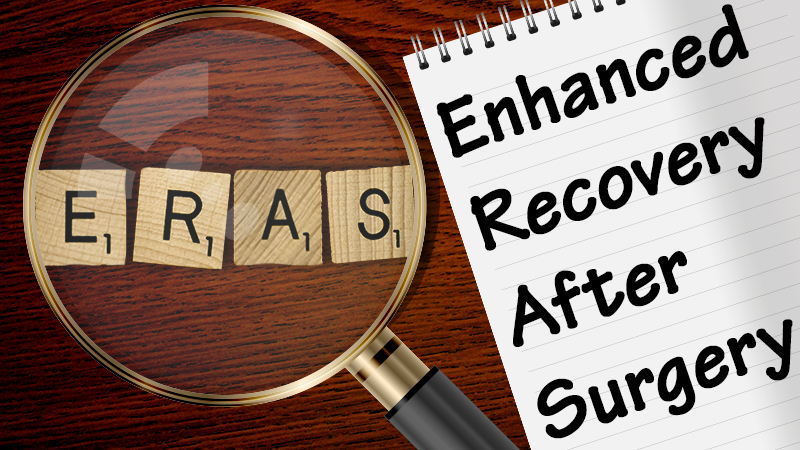
Practice Perfect 660
ERAS Protocol
Part 2: What’s the Evidence?
ERAS Protocol
Part 2: What’s the Evidence?

In last week’s issue of Practice Perfect, we introduced the concept of the ERAS (Enhanced Recovery After Surgery) protocol. We reviewed the different aspects of what it is, and, as promised, we’ll take a quick look at the evidence to see if ERAS is actually beneficial and how applicable it is to podiatric surgical practice.
One major limitation to figuring this out, as I mentioned last week, is that most of the research about ERAS effectiveness comes from general surgery because the process was originally created for gastrointestinal surgery. The research support for orthopedic procedures is minimal and clinical practice guidelines are under development. There’s one other comment worth considering before we get to the actual research evidence. Part of the ERAS process is for each hospital and unit to periodically review and audit their system with a goal to make improvements.1 I like this, since an honest appraisal of any process is important for true change and progress to occur. This philosophy also lends itself naturally to future research and evidence for the medical community to consider.
Let’s first list the important outcomes that would help us evaluate the effectiveness of the ERAS protocol.
General Outcomes
- Increased patient satisfaction
- Decreased all cause complications
- Decreased hospital unintended admissions and readmissions
Specific Outcomes
- Decreased hospital length of stay
- Decreased episodes of nausea and vomiting
- Decreased patient postoperative pain
- Complications related to altered NPO methods
Instead of going through all of these outcomes, I’m going to focus on the ones that matter most to the podiatrist: pain and complications.
We’ll make quick work of pain. The effectiveness of regional anesthetic blockade has been well studied and was reviewed in Practice Perfect #540 POP Goes The Block where we discussed the idea of preemptive analgesia. What about the method of prophylactically administering NSAIDs and neurological medications to prevent postop pain? Two clinical practice guidelines, one from the American Pain Society3 and the other from the American Society of Anesthesiologists4, recommend using multimodal pain management methods, both preoperatively and postoperatively. It also makes logical sense that using methods that target different physiological pathways would work synergistically to decrease pain. Take a look back to last week’s Practice Perfect for recommendations on specific perioperative prescriptions.
Using multiple methods that target different physiological pain pathways work synergistically to decrease pain
Let’s look now at the altered NPO recommendations of stopping solid foods at six hours preop and clear liquids at two hours before a procedure. This is in contradistinction to the current NPO after midnight rule. Back in 2003, the Cochrane review published a study on just this subject (how convenient for us). They selected 22 randomized controlled trials comparing various fasting protocols and found no difference in regurgitation, aspiration, or morbidity with shorter fasts compared with NPO after midnight regimens.2 The one caveat to this is that the majority of studies examined otherwise healthy patients. Despite this, it appears safe to decrease the length of preoperative fasting.
It appears safe to decrease the length of preoperative fasting.
Unfortunately, there is no quality research looking at outcomes after foot and ankle surgery using the ERAS protocol. Instead, we’ll extrapolate from the limited orthopedic surgery that exists. Deng, et al performed a systematic review and meta-analysis of outcomes after total hip and knee arthroplasty procedures, finding 25 studies and almost 17,000 patients. Compared with conventional care, ERAS showed a decrease in overall complications, mortality, length of stay, and transfusions.5 The literature strongly supports protocols of this sort to improve surgical outcomes.
To summarize our discussion on the Enhanced Recovery After Surgery protocol, one should first be aware that this requires a multi-disciplinary team approach to the care of patients. That means, for those of you interested in starting this program at your local hospital, you can’t do it alone. It is instructive, then, to close out this discussion with a focus on some of the methods each of us might use to help our patients.
Pre-Hospital Admission
- Educate the patient on all aspects of their perioperative situation.
- Push for smoking and alcohol cession.
- Optimize the patient medically, including nutritional screening.
Preoperative
- Begin NPO status six hours preop and clear water two hours preop.
- Prophylax against nausea and vomiting according to the APFEL score (see last week’s editorial).
- Dose Celebrex® 400mg once and gabapentin 600mg once, both one hour before surgery. Consider other anti-inflammatories depending on the patient’s medical history.
Intraoperative
- Utilize pre-emptive analgesia with a pre-procedure popliteal and saphenous nerve block. Consider an indwelling catheter for continuous infusion in larger cases with an anticipated greater pain response.
- Use warm IV fluids and warming system to keep the patient’s temperature constant.
Postoperative
- Immediately encourage early fluid and food intake and range of motion when possible.
- Utilize a multimodal approach to pain management to limit opioid use. Consider NSAIDs, gabapentin, pregabalin.
- Control postop nausea with a multimodal approach similar to that in the preoperative period.
It appears Enhanced Recovery After Surgery (ERAS) is the method on the horizon to help us replace the heavy use of opioids previously employed. Future research will help us better understand these protocols on patients undergoing foot and ankle surgery, so there will be more to come!

-
Ljungqvist O, Scott M, Fearon KC. Enhanced Recovery After Surgery: A Review. JAMA Surg. 2017 Mar 1;152(3):292-298.
Follow this link -
Brady M, Kinn S, Stuart P. Preoperative fasting for adults to prevent perioperative complications. Cochrane Database Syst Rev. 2003;(4):CD004423.
Follow this link -
Practice Guidelines for Acute Pain Management in the Perioperative Setting. Anesthesiology. 2012 Feb;116(2):248-273.
Follow this link -
Chou R, Gordon DB, de Leon-Casasola OA, et al. Guidelines on the Management of Postoperative Pain. J Pain. 2016 Feb;17(2):131-157.
Follow this link -
Deng QF, Gu HY, Peng WY, et al. Impact of Enhanced Recovery After Surgery On Postoperative Recovery After Joint Arthroplasty: Results From a Systematic Review and Meta-analysis. Postgrad Med J. 2018 Dec;94(1118):678-693.
Follow this link































Comments
There are 0 comments for this article